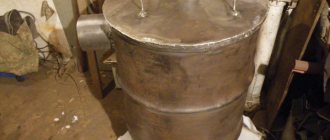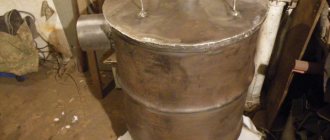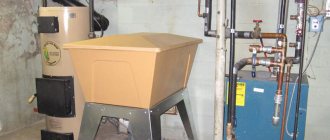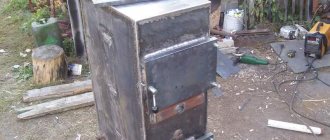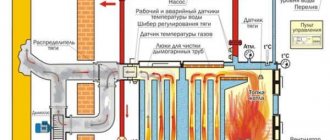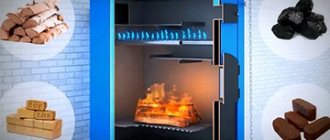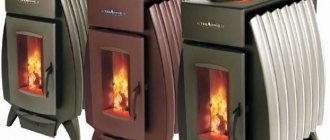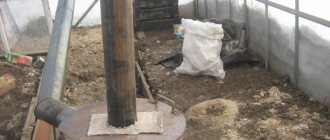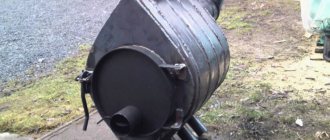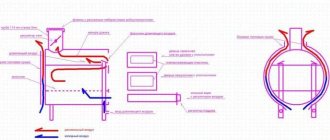In modern times, few homeowners are ready to purchase heating equipment without thoroughly understanding what they are paying their hard-earned money for. This also applies to solid fuel boilers, whose range is quite wide. But for one person it is enough to know the technical characteristics of the equipment, while for another it is important to understand the operating principle of a particular heat generator. We present to your attention the currently existing diagrams of solid fuel boilers with a description of their operation. They may differ in detail for different products, but this will not affect the general principle.
Classic solid fuel boilers
This is the most common type of heating installations that burn solid fuel; they are also called direct combustion boilers. Due to their simplicity of design, these units are the cheapest of all and therefore are most often purchased by homeowners.
They are also popular among do-it-yourselfers, which is why it is not difficult to find drawings for the manufacture of traditional heat generators. The units can be divided into 2 types:
- non-volatile, operating on natural chimney draft;
- supercharged, with forced air injection.
The first operate on the principle of a conventional stove, only “clad” in a water jacket. The volumetric fuel chamber is located above the ash pan, separated from it by grates. Air from the room enters the firebox through the damper in the ash pan door and the grate. Its quantity is regulated by a chain-driven thermostat, which is guided by the temperature of the water in the boiler jacket and controls the air damper mechanically. For a better understanding of the process, a diagram of a solid fuel boiler is shown below:
Flue gases released in the firebox pass through the flame tubes of the heat exchanger, washed externally with water. Depending on the design of the heater, combustion products can make 2 or 3 passes through the gas ducts, intensively exchanging heat with the water jacket. Having given up their heat, the gases leave the unit through the chimney.
Note. In the above diagram of the heat generator, the flame tubes are located horizontally. There are models with vertical gas ducts, but this is not decisive.
Non-volatile solid fuel units cannot boast of high efficiency, a maximum of 70%. The duration of combustion depends on the volume of the firebox and the operating mode, although it is strongly recommended to use them in conjunction with a heat accumulator. The second type of boilers is more productive; their efficiency reaches 75% due to forced air supply by a fan. The design of such an installation is well reflected in the operation diagram of a solid fuel boiler presented below:
Characteristics of gas heaters
The main fuel of the units is a natural mixture of methane-based gases obtained from main pipelines. When it is necessary to organize autonomous gas heating, it is possible to switch to a liquefied propane-butane mixture supplied from a gas holder or a ramp with cylinders.
Depending on the installation method, the units are wall-mounted and floor-mounted, and the latter usually do not require electricity. Mounted heat generators are mini-boiler rooms equipped with an expansion tank, a circulation pump and an electronic control unit.
According to the method of fuel combustion and efficiency, gas heaters are divided into 3 categories:
- Atmospheric, open combustion chamber, efficiency - up to 90%. Air is supplied to the burner naturally from the boiler room, and the gases that give off heat are discharged into a traditional chimney.
- Turbocharged (supercharged), combustion chamber is completely closed, efficiency - 93%. The air is pumped by a fan, the smoke goes out into the street through a double-walled coaxial pipe.
- Condensing units use the latent heat of combustion of hydrocarbons, so the efficiency reaches 96-97%. The design is similar to a turbocharged boiler, but the closed chamber and burner are cylindrical in shape.
Turbocharged model of a suspended boiler equipped with a plate heat exchanger for heating water.
All of these heaters can be supplied with a DHW water circuit. For this purpose, 2 types of heat exchangers are used - a separate plate made of stainless steel and a copper shell-and-tube (built inside the main heater).
The price of boilers increases in the order of listing - atmospheric units are considered inexpensive, then there are heaters with a turbine. The cost of condensing equipment is approximately twice as high as conventional heat generators (from one manufacturer).
Low temperature condensing units are well suited for heating underfloor heating
Advantages of gas boilers:
the devices are quite economical and reliable in operation; high degree of automation - the homeowner does not need to pay attention to the device; ease of operation, maintenance – once a year; the boiler room is clean, the noise level is low; for the pressurized model you do not have to build a classic chimney - the pipe is routed horizontally through the wall.
As for the disadvantages : the gas heat generators themselves are flawless, the problem is different - connecting the main line to a private house and obtaining the necessary permits. The first service costs a lot of money, the second takes a lot of time. An intermediate option is a device for autonomous supply of liquefied gas from cylinders or underground containers.
Long burning boilers
These units are no better in efficiency than traditional ones, their indicators are approximately the same: for atmospheric boilers - up to 70%, for forced-air boilers - up to 75%. But the duration of combustion from one stack of firewood or coal is actually increased. This is achieved thanks to the following technical solutions:
- increased dimensions of the fuel chamber, which can accommodate twice as much firewood as in a conventional boiler;
- The combustion method is unconventional - from top to bottom.
Such heat generators have a cylindrical shape, since it is hardly possible to implement the idea in a rectangular body. The firebox is filled to the top with wood, ignited from above, and then a load with a hole for air passage is lowered onto it using a telescopic pipe. As it burns, the load is lowered, which is why air is constantly supplied directly to the flame zone. The illustration below shows a diagram of a long-burning solid fuel boiler:
The air also passes through the telescopic pipe from top to bottom, driven by the natural draft of the chimney or forced by a fan. The design does not provide for a heat exchanger; the process of heating the coolant occurs directly, although the flue gases also manage to give up some of their heat. Thanks to the described combustion method, the boiler and heating system can operate with one load of wood for up to 12 hours, and coal for up to 2 days.
Features of fuel loading and operation
Assembling a heating system
From a simple boiler, where a full air supply is necessary throughout the entire volume of fuel combustion, the long-burning design, as noted earlier, is distinguished by the limitation of this supply. Moreover, the loading volume directly affects the burning time, so in our case the combustion chamber is loaded extremely tightly so that there are no gaps.
Firebox from the inside
Note! You can use not only firewood as fuel, but also sawdust, coal, peat, garbage (exclusively combustible), etc.
Fuel is loaded in this order.
Loading the boiler
Test firing of the boiler
Step 1. Remove the top cover of the structure.
Step 2: Remove the air regulator.
Step 3. The boiler is loaded with fuel up to the level of the chimney pipe.
Step 4. A small amount of lighter fluid (diesel fuel, used oil, etc.) is poured over the top of the fuel.
Step 5. The air regulator is installed back, the cover is put on top.
Step 6. The air damper is opened to its maximum.
Step 7. A piece of paper is set on fire and thrown into the structure. When the fuel begins to smolder, the air damper closes.
Heating system. Harness
Heating system. Harness
The fact that permanent combustion has begun can be judged by the smoke emerging from the chimney. As the fuel burns, a pipe of smaller diameter will lower along with the air regulator - using this kind of indicator, you can determine the amount of remaining fuel.
Pyrolysis boilers
The operating principle of these heat generators is based on separate combustion in two chambers communicating with each other through a nozzle made of refractory bricks. In the primary chamber, located on top, firewood smolders with limited air supply from the fan. As a result, a process of pyrolysis occurs, otherwise known as gasification, during which a mixture of flammable gases is released. It moves to the second chamber, where it is burned when secondary air enters. The working diagram of a pyrolysis boiler operating on solid fuel is as follows:
Flue gases from the secondary furnace enter the fire tube heat exchanger in the form of vertical flues surrounded by a water jacket. There they cool, transferring heat to the water, and leave the boiler through the chimney pipe. The performance of the fan is controlled by an electronic unit - controller, based on the readings of pressure and temperature sensors.
In general, the heat generator has good efficiency indicators - about 80%, but the unit is significantly more expensive than a classic one. In addition, the boiler shows high efficiency only when operating on dry wood, although this statement is also true for other solid fuel units.
Process steps
Algorithm for assembly and connection to the home heating system:
- Preparation of the base - a cylindrical body.
- Organization of the ash pit.
- Furnace, air supply and adjustment device.
- Making a chimney.
- Heat exchanger assembly.
- Testing and installation.
When assembling the stake, it is important to comply with the drawings.
At each stage, accuracy and precision and full compliance with the drawings are important. Durability, reliability and operational safety depend on this.
Marking and manufacturing of the body
The diameter of the pipe is from 30 to 80 cm. The recommended proportions of the height to the width of the firebox are from 3:1 to 5:1. Otherwise, the fuel burns unevenly or too quickly.
Steel thickness is from 4 to 6 mm. Thin metal quickly burns out (the situation is aggravated by increased carbon deposits), too thick metal increases the inertia of the system and leads to boiling of the coolant.
The pipe or cylinders selected for the boiler are cut and welded according to the dimensions of the drawing. The bottom and legs are welded on from below.
Cutting out windows:
- loading and ash pan;
- for the chimney.
If the pipe for the housing is short or there is only 1 cylinder, the combustion chamber is enlarged due to top filling. Instead of a loading door, a removable lid is made.
Its simple dismantling and installation is important. And for a tight fit, the body is scalded inside and out with a metal strip - the resulting fit is sealed with an asbestos cord.
The body is cut and welded according to the dimensions of the drawing.
An air duct pipe will move through the boiler lid. It is necessary to burn a hole under it, weld on a collar - a piece of pipe for a sliding fit. It minimizes unwanted air leaks.
Pipe
It is connected to the chimney pipe. Through it, hot smoke is released into the atmosphere. For safe passage through a ceiling or wall, the pipe is equipped with a “cut”.
This steel sheet is the basis for the asbestos substrate. This prevents direct contact of the hot pipe with the surrounding materials.
Pipe to the chimney
This horizontal pipe welded into the body is often equipped with a rotary valve to adjust the draft. It is connected to the main chimney pipe with a sealing clamp or through an outlet with a socket - for turning up or in the desired direction.
Ash pan
This is the bottom part of the boiler. A rectangular neck is welded into its window, which is closed with a door.
This design was not chosen by chance:
- It is easier to ensure that it is sealed tightly.
- It is easy to install a controlled curtain in a flat door to regulate the intensity of combustion.
The ash pan is the bottom part of the boiler.
Air supply system
This is a kind of press that limits the firebox as fuel is consumed, providing an influx of oxygen.
The recommended diameter of the air duct pipe is 80% of the body, the height is greater than the boiler.
A disc is cut out of a steel sheet. Its diameter is 5–10 mm smaller than the internal size of the case. The minimum clearance should not interfere with freedom of movement.
The whole structure resembles a large piston:
- A hole is burned in the center, an air duct is threaded through it and grabbed.
- At the bottom of the disk, corners, channels or steel strips are welded with rays - these are the channels of the air distributor.
A controlled damper is attached to the upper end of the air duct to regulate the oxygen supply.
Heat exchanger
To heat the coolant, a water jacket 5–6 cm thick is welded around the combustion chamber.
The easiest way:
- find a barrel of a suitable size;
- cut holes in the bottom and lid according to the outer diameter of the cylinder;
- screw in the supply and return pipes for connection to the heating system;
- put the barrel on the boiler, weld the joints.
A heat exchanger is needed to heat the combustion chamber.
If a ready-made container cannot be found, the heat exchanger is welded from a pipe of a larger diameter, or, in extreme cases, from sheet iron. And since thick iron cannot be bent around the body, you will have to choose a more pliable one.
The efficiency of the boiler can be increased by preheating the coolant from the chimney passing through a separate tank.
Grill installation
From above, the ash pan is separated from the combustion chamber:
- ready-made grates;
- thick rods or reinforcement welded into a cage;
- steel grate, cut to fit the inner diameter of the cylinder.
It is advisable to weld into the body not the grate itself, but the supports under it - for easy replacement in case of burnout.
Test ignition
The finished boiler is installed on a pedestal and equipped with a temporary chimney.
To load firewood and kindling you need:
- remove the cover, remove the air distributor;
- put firewood in the firebox up to the chimney;
- put the parts back together;
- open the ash pan and ignite the fuel - throw lit paper into the pipe;
- To make sure that smoldering has begun, close the door tightly.
For a finished boiler, you need to carry out a test ignition.
Any fuel - firewood, coal, pellets - is loaded as tightly as possible, when there is no free space between the layers. If this does not work, then all the voids are covered with sawdust, wood chips, and filled with paper. The basic principle: the denser it is laid, the longer it smolders.
Due to the burning of wood, the air duct pipe gradually lowers - from it you can judge the remaining amount of fuel.
After a test run, the heater is installed in the house.
Pellet boilers
This group of heat generators is the most progressive of all, although the most expensive. Both the heater itself and its installation and connection will be expensive. But pellet boilers are worth the money: they are efficient (efficiency - up to 85%), fully automated and devoid of the inertia inherent in other solid fuel “brothers”. Since the fuel reserve in the bunker is enough for 3-7 days of operation, they can be safely classified as long-burning units.
Structurally, the installations are similar to gas heaters, since they are equipped with two types of burners: retort and torch. The figure shows a drawing of a long-burning solid fuel boiler using pellets with different types of burners:
The organization of heat transfer here is the same as in other heat generators - using fire tube heat exchangers. High efficiency is achieved due to something else: dry, high-quality fuel and automatically controlled combustion. But if you come across wet or loose pellets, then the efficiency of the unit will sharply decrease.
For reference. Automatic coal boilers operate on the same principle, only the burners in them are of one type - retort.
Useful tips and general recommendations from experienced craftsmen
For long-term stable operation of the heating system with a homemade boiler, it is important to remember that:
- Gaskets and latches that seal open lids and doors improve installation efficiency.
- If a wood-burning boiler is used in conjunction with an electric one, the damper on the chimney will reduce heat loss.
- Automatic control increases the operating comfort of the unit.
- Installation on a concrete floor eliminates distortions and ensures the durability of the heat exchanger pipes.
Accurate and high-quality in-house execution is important to obtain an equivalent alternative to factory assembly.
A little about DHW circuits
Due to their characteristics, any solid fuel heaters are poorly suited for direct heating of water for domestic hot water needs. Nevertheless, some manufacturers still integrate a second circuit in the form of a coil into their products. At the same time, the design of double-circuit solid fuel boilers can be different; the coil can be located inside the water jacket and heated by the coolant. In other models it is placed inside the firebox or above it.
The best option is not to place a heat exchanger inside a wood-burning heat generator, but to prepare water in an indirectly heated boiler, which will also serve as a heat accumulator. But not everyone can afford to purchase such equipment, so users are still interested in dual-circuit units, although they are unlikely to be able to provide all the needs for hot water. Below is a diagram of installing a boiler with a function of heating water for domestic hot water:
Safety regulations
Operating the boiler requires constant care.
Generally accepted standards for safe operation:
- finish the premises with fireproof materials;
- store fuel separately.
Small heaters with a power of up to 35 kW can be placed not in a separate room, but in an enclosed space with constant ventilation.
Rules for safe distances from the firebox:
- to the opposite wall - at least 1.25 m;
- to the rear and side walls - at least 0.7 m.
All hazardous surfaces and areas are protected with fireproof materials.
Review of popular models
It should be understood that any pyrolysis boiler is a fairly heavy unit that is not intended for hanging on the wall. Such devices can be used both for heating a small house and spacious cottages. Like other heating units, long-burning boilers vary in power.
When choosing a pyrolysis combustion boiler, you should focus on such indicators as the thermal power of the device, the size of the loading chamber, the presence of a secondary circuit, etc.
Buyers usually focus on this indicator.
Among the popular models of such equipment we should mention:
- Atmos (Ukraine) - presented by devices that can operate on both wood and coal, power varies from 14 to 75 kilowatts.
- Attack (Slovakia) - capable of heating areas up to 950 sq. m, some models are able to continue working even during power outages.
- Bosch (Germany) - high-quality products from a well-known brand, power varies between 21-38 kilowatts.
- Buderus (Germany) is represented by the Elektromet and Logano , the first is well known in Europe as a classic version of a pyrolysis boiler, the second is more modern versions intended for private homes.
- Gefest (Ukraine) - high-power devices with efficiency up to 95%.
- KT-2E (Russia) is specially designed for large residential premises, the unit power is 95 kilowatts.
- Opop (Czech Republic) - relatively inexpensive boilers, reliable and durable, power 25-45 kilowatts.
- Stropuva (made in Lithuania or Ukraine) with a power of seven kilowatts or more are quite suitable for a small home, but the model range also includes more powerful devices.
- Viessmann (Germany) is an ideal choice for private households, power starts from 12 kilowatts, the use of modern technologies allows you to save fuel.
- “Buran” (Ukraine) with a power of up to 40 kilowatts is another popular option for owners of large cottages.
- “Logika” (Poland) high-power devices of 20 kilowatts easily heat rooms up to 2 thousand square meters. m, it is more of a boiler for industrial needs: heating workshops, offices, greenhouses, etc.
When choosing a pyrolysis boiler for a private home, you should pay attention to models with two circuits, in order not only to heat the home, but also to provide it with an autonomous hot water supply.
The heat exchanger for hot water supply can be storage or flow type. For the latter option, boiler models with increased thermal power are used.
If you want to save money, you can try making a pyrolysis boiler with your own hands. The technology for its assembly is described in this article.

